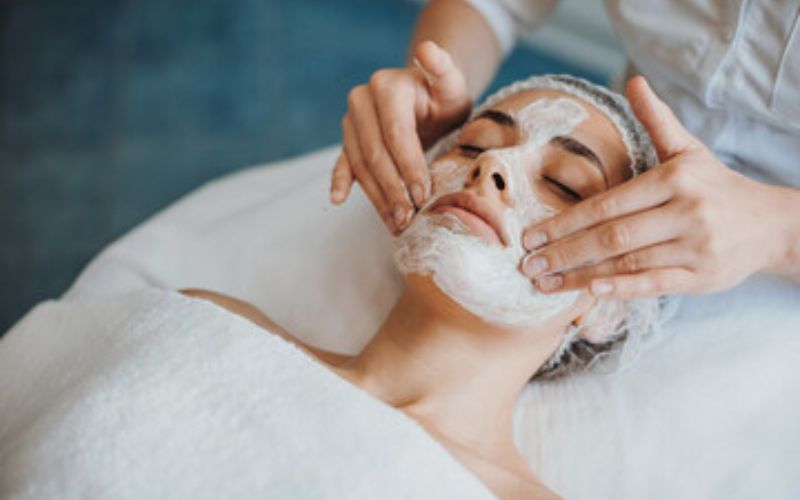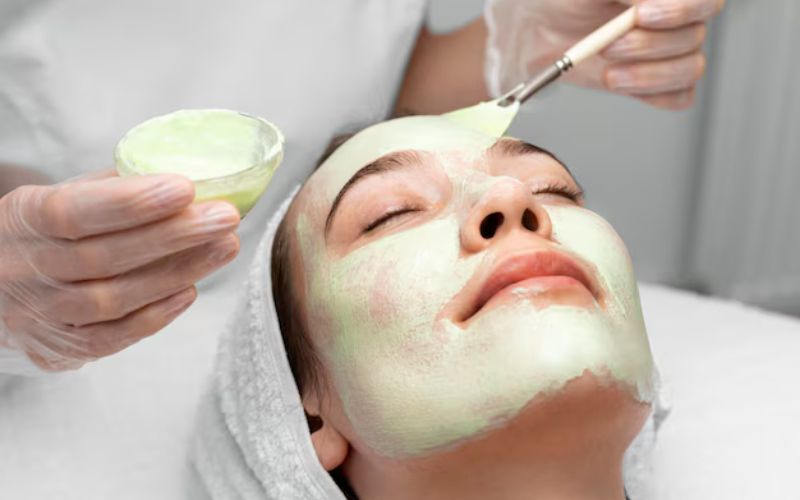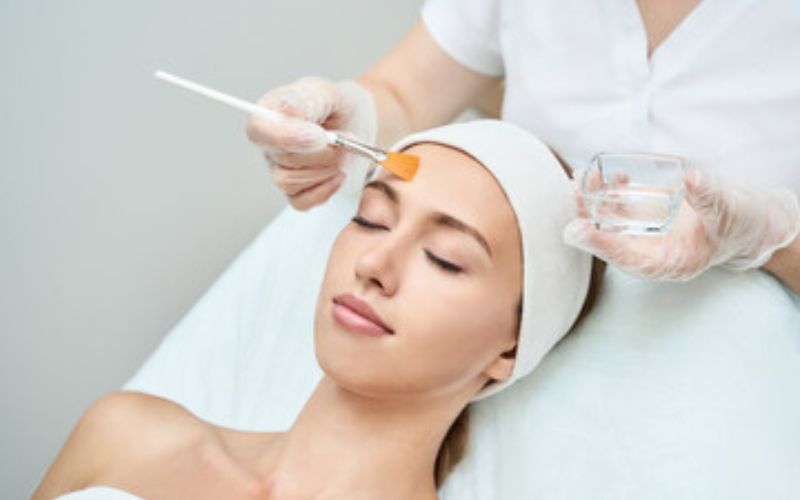Introduction
In the pursuit of flawless skin, chemical peels have emerged as a popular treatment option. But do they really work? This blog delves into the science, benefits, risks, and effectiveness of chemical peels, providing you with everything you need to know before considering this treatment. Whether you're looking for a solution to acne scars, fine lines, or uneven skin tone, this guide will help you understand if chemical peels are right for you. At KJ Aesthetics, under the expert guidance of Dr. Vishal Brahmabhatt, we prioritize your skin health, offering personalized treatments that deliver real results. If you're searching for a facial peel, our clinic is equipped to provide top-tier care and customized treatment plans.
What is a Chemical Peel?
A chemical peel is a cosmetic treatment used to improve the appearance of the skin on the face, neck, or hands. A chemical solution is applied to the skin, causing it to exfoliate and eventually peel off. The new skin underneath is usually smoother, with fewer wrinkles, and may be more evenly colored.

Types of Chemical Peels
Superficial Peels: These use mild acids like alpha-hydroxy acid (AHA) to gently exfoliate. They only penetrate the outermost layer of skin and are used to improve the appearance of mild skin discoloration and rough skin.
Medium Peels: These use trichloroacetic or glycolic acid to reach the middle and outer layers of skin. This makes them effective for treating age spots, fine lines, and wrinkles.
Deep Peels: These involve phenol or stronger acids that deeply penetrate the middle layer of the skin. Deep peels are used for more severe skin conditions, such as deep wrinkles or scars.
How Do Chemical Peels Work?
Chemical peels work by removing layers of skin using a chemical solution, which causes controlled damage to the skin. As the skin heals, new skin cells emerge, making the surface appear smoother and more youthful. The process also stimulates the production of collagen, which helps to firm the skin.
Benefits of Chemical Peels
Skin Rejuvenation Chemical peels are known for their ability to rejuvenate the skin by improving texture, tone, and overall appearance. This procedure can address multiple skin concerns at once, making it a versatile option for those looking to enhance their skin’s health and beauty.
Treatment of Acne Scars One of the significant benefits of chemical peels is their effectiveness in treating acne scars. The procedure helps in reducing the appearance of scars by removing the top layers of skin, which encourages new skin growth and reduces the depth of the scars.
Reduction of Fine Lines and Wrinkles As we age, our skin loses its elasticity, leading to fine lines and wrinkles. Chemical peels can reduce these signs of aging by promoting collagen production and new skin growth, resulting in smoother and younger-looking skin.
Improvement of Skin Tone and Pigmentation Chemical peels can effectively treat hyperpigmentation, melasma, and sun damage by exfoliating the pigmented skin and promoting the growth of new, evenly toned skin.
Research and Expert Opinions
According to a study published in the Journal of Clinical and Aesthetic Dermatology, superficial chemical peels are particularly effective in treating acne, with a significant reduction in acne lesions observed after several sessions. Furthermore, Dr. Vishal Brahmabhatt of KJ Aesthetics emphasizes that chemical peels, when performed correctly, can deliver substantial improvements in skin texture and tone, making them a valuable tool in aesthetic medicine.

Is Chemical Peeling Permanent?
Chemical peels do not produce permanent results. The effects of a chemical peel are long-lasting but not permanent because the skin continues to age, and new skin issues may arise over time. For example, while a chemical peel can effectively reduce fine lines, wrinkles, and pigmentation, the skin will eventually continue to age, and factors like sun exposure, lifestyle, and genetics will influence the skin's condition. Therefore, maintenance treatments may be needed to sustain the results.
How Many Sittings for Chemical Peeling?
The number of sittings required for chemical peeling depends on several factors, including the type of peel, the skin condition being treated, and the desired outcome.
Typically
Superficial Peels: These mild peels may require 4 to 6 sessions, spaced about 2 to 4 weeks apart, to achieve the desired results.
Medium Peels: Usually, 2 to 4 sessions are recommended, with each session spaced 3 to 6 months apart.
Deep Peels: Deep peels are more intensive and often only one session is needed. However, they require a longer recovery time, and the results can last for several years.
How Long Do Chemical Peels Last?
The duration of the effects of a chemical peel varies depending on the depth of the peel and the individual's skin care routine:
Superficial Peels: The results can last several weeks to a few months. Regular maintenance treatments are often recommended to keep the skin looking refreshed.
Medium Peels: The effects can last 1 to 2 years, depending on your skin care regimen and sun protection habits.
Deep Peels: Results from a deep peel can last several years, often up to 10 years, but the skin will continue to age naturally.
Potential Risks and Side Effects
While chemical peels offer numerous benefits, they also come with potential risks and side effects, especially if not performed by a qualified professional.
Common Side Effects
Redness and Peeling: Most patients experience redness and peeling after the procedure, which can last for several days.
Sensitivity: The new skin may be more sensitive to the sun, requiring diligent use of sunscreen.
Rare but Serious Risks
Scarring: Although rare, deep chemical peels can cause scarring, especially in people with certain skin types.
Infections: There is a small risk of bacterial, fungal, or viral infection following a chemical peel.
Pigmentation Changes: Some people may experience changes in skin color, particularly those with darker skin tones.
Minimizing Risks To minimize risks, it’s crucial to have a thorough consultation with a qualified professional like Dr. Vishal Brahmabhatt at KJ Aesthetics. Proper pre- and post-treatment care is essential to avoid complications and achieve the best possible results.
Who Should Consider a Chemical Peel?
Chemical peels are suitable for a wide range of individuals, but certain factors must be considered to determine if you are an ideal candidate. Ideal Candidates Individuals with
Fair Skin: Chemical peels tend to work best on individuals with fair skin, as there is less risk of pigmentation changes. Those Looking to Treat Specific
Skin Concerns: If you have acne scars, fine lines, wrinkles, or uneven skin tone, a chemical peel may be an appropriate treatment option.
Considerations Based on Skin Type and Color
Individuals with darker skin tones may still benefit from chemical peels, but the procedure must be carefully tailored to avoid unwanted pigmentation changes. At KJ Aesthetics, we specialize in customizing treatments to suit each patient’s unique skin type and concerns.
KJ Aesthetics and Dr. Vishal Brahmabhatt
Understanding what to expect during and after a chemical peel can help you prepare for the procedure and ensure a smooth recovery.
The Procedure Preparation: Before the peel, your skin will be cleansed, and protective measures will be applied to sensitive areas like the eyes and hair.
Application: The chemical solution is applied to the skin, where it will remain for a specific amount of time, depending on the type of peel.
Neutralization and Removal: The peel is neutralized and removed, and a soothing ointment or sunscreen is applied.
Post-Treatment Care Immediate Aftercare: Expect redness, peeling, and possible swelling, especially with deeper peels.
Recovery Timeline: Superficial peels require minimal downtime, while deeper peels may need several weeks of recovery.
Long-Term Care: Sun protection is vital after a peel to prevent complications and maintain results.
What to Expect During and After a Chemical Peel
At KJ Aesthetics, Dr. Vishal Brahmabhatt is a board-certified professional with years of experience in performing chemical peels. Our clinic is dedicated to providing personalized care, ensuring that each patient receives the treatment best suited to their needs. If you are searching for a facial peel, we offer top-tier services that prioritize safety and effectiveness.
Frequently Asked Questions (FAQ)
The cost of a chemical peel varies depending on the type and depth of the peel. At KJ Aesthetics, we offer competitive pricing with personalized consultations to determine the best treatment plan for you.
Conclusion
Chemical peels offer a powerful solution for various skin concerns, from hyperpigmentation and acne scars to fine lines and wrinkles. Understanding the different types of chemical peels and choosing the right one for your skin can make a significant difference in your results. At KJ Aesthetics, Dr. Vishal Brahmabhatt and his team are dedicated to helping you achieve your best skin with safe, effective, and personalized chemical peel treatments.

